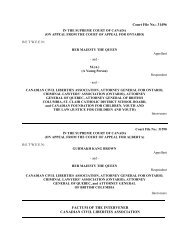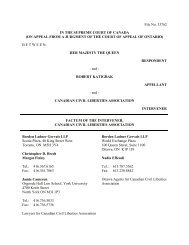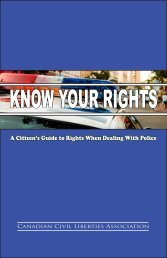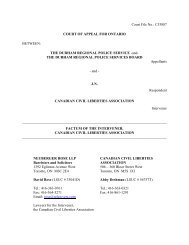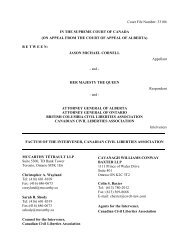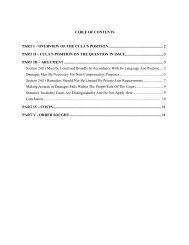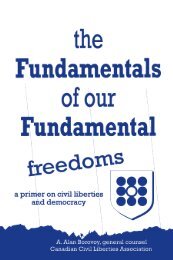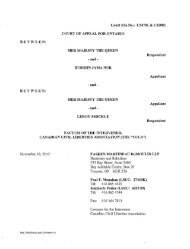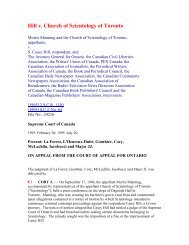Read CCLA's factum in the Whatcott case here - Canadian Civil ...
Read CCLA's factum in the Whatcott case here - Canadian Civil ...
Read CCLA's factum in the Whatcott case here - Canadian Civil ...
- No tags were found...
Create successful ePaper yourself
Turn your PDF publications into a flip-book with our unique Google optimized e-Paper software.
narrower “hate speech” provision <strong>in</strong> Canada (Human Rights Commission) v. Taylor. 2S<strong>in</strong>ce Taylor, experience with such provisions <strong>in</strong> human rights codes has shown that <strong>the</strong>majority’s assumptions <strong>in</strong> that <strong>case</strong> have not generally been borne out. Ra<strong>the</strong>r, thisexperience has demonstrated that human rights tribunals face extreme difficulty <strong>in</strong>characteriz<strong>in</strong>g contentious expression and determ<strong>in</strong><strong>in</strong>g whe<strong>the</strong>r that expression meets<strong>the</strong> threshold articulated by this Court <strong>in</strong> Taylor.2. The CCLA has <strong>in</strong>tervened <strong>in</strong> many <strong>case</strong>s w<strong>here</strong> compla<strong>in</strong>ants have engaged <strong>the</strong>use of human rights codes to limit and/or restrict expression that <strong>the</strong>y f<strong>in</strong>d offensive.These <strong>in</strong>clude Lund v. Boisso<strong>in</strong> and The Concerned Christian Coalition Inc. 3 <strong>in</strong> Alberta,Owens v. Saskatchewan (Human Rights Commission) 4 <strong>in</strong> Saskatchewan, and Elmasryet al. v. Rogers Publish<strong>in</strong>g Limited et al. 5 <strong>in</strong> British Columbia. The CCLA has also beengranted <strong>in</strong>tervenor status <strong>in</strong> <strong>the</strong> pend<strong>in</strong>g <strong>case</strong> of Warman v. Lemire, 6 which concerns<strong>the</strong> amended version of <strong>the</strong> federal provision that was at issue <strong>in</strong> Taylor. Like <strong>the</strong> <strong>case</strong>at bar, <strong>the</strong>se <strong>case</strong>s illustrate <strong>the</strong> <strong>in</strong><strong>here</strong>nt difficulty <strong>in</strong> draw<strong>in</strong>g a co<strong>here</strong>nt l<strong>in</strong>e betweenpolemical statements of op<strong>in</strong>ion, and hate speech.3. While <strong>the</strong> CCLA advocates for a robust protection for freedom of expression, <strong>the</strong>CCLA strongly disagrees with <strong>the</strong> content of <strong>Whatcott</strong>’s expression. Indeed, <strong>the</strong> CCLAhas long supported <strong>the</strong> rights of members of <strong>the</strong> LGBT communities to be free fromdiscrim<strong>in</strong>ation. The CCLA has also vigorously defended <strong>the</strong> freedom of expression ofmembers of <strong>the</strong> LGBT communities <strong>in</strong> circumstances w<strong>here</strong> <strong>the</strong>ir expression has beenchallenged as be<strong>in</strong>g outside of <strong>the</strong> ma<strong>in</strong>stream. 7 While this appeal may becharacterized by some as a conflict between equality rights and freedom of expression,2 Canada (Human Rights Commission) v. Taylor, [1990] 3 S.C.R. 892 [“Taylor”]3 2009 ABQB 592 [“Boisso<strong>in</strong>”].This <strong>case</strong> exam<strong>in</strong>ed <strong>the</strong> extent to which Alberta human rights law can limita homophobic letter to <strong>the</strong> editor.4 2006 SKCA 41 (CanLII) [“Owens”]. This <strong>case</strong> exam<strong>in</strong>es <strong>the</strong> extent to which s.14(1)(b) of <strong>the</strong> Code canlimit an anti-homosexual advertisement.5 2008 BCHRT 378 (CanLII) [“Elmasry”]. This <strong>case</strong> concerns a compla<strong>in</strong>t that an article written bycolumnist Mark Steyn <strong>in</strong> Macleans Magaz<strong>in</strong>e amounts to “hate speech” aga<strong>in</strong>st Muslims.6 Federal Court of Canada, File No. T-1640-09) (Hear<strong>in</strong>g scheduled for December 13, 2011); Warman v.Lemire, 2009 CHRT 267 Little Sisters Book Shop and Art Emporium v. Canada (Attorney General), [2000] 2 S.C.R. 1120; R. v.Glad Day Bookshop Inc., [2004] O.J. No. 1766 (Ont. Sup. Ct. Jus.)2
<strong>the</strong> CCLA notes that <strong>the</strong> right to express oneself on controversial issues, even <strong>in</strong>polemical terms, is often an important tool <strong>in</strong> <strong>the</strong> arsenal of equality-seek<strong>in</strong>g groups.4. Put simply, provisions such as s.14(1)(b) do not work. They are overbroad <strong>in</strong><strong>the</strong>ir application, lack objective standards, and encourage litigation over matters that arebetter left to <strong>the</strong> marketplace of ideas. In a robust democracy, polemical expressionsuch as <strong>Whatcott</strong>’s flyers may be denounced and countered, but should not be banned.PART II – CCLA’S POSITION ON POINTS IN ISSUE5. The CCLA takes <strong>the</strong> follow<strong>in</strong>g position on <strong>the</strong> po<strong>in</strong>ts raised by <strong>the</strong> Appellant:a) Section 14(1)(b) <strong>in</strong>fr<strong>in</strong>ges s.2(b) of <strong>the</strong> Charter;b) The <strong>in</strong>fr<strong>in</strong>gement of s.2(b) is not saved by s.1;c) Section 14(1)(b) <strong>in</strong>fr<strong>in</strong>ges s.2(a) of <strong>the</strong> Charter;d) The <strong>in</strong>fr<strong>in</strong>gement of s.2(a) is not saved by s.1; ande) In <strong>the</strong> alternative, s.14(1)(b) was not contravened.PART III - ARGUMENTA. Section 14(1)(b) Infr<strong>in</strong>ges Freedom of Expression6. The Appellant has conceded that s.14(1)(b) <strong>in</strong>fr<strong>in</strong>ges s.2(b) of <strong>the</strong> Charter.B. The Infr<strong>in</strong>gement of s.2(b) is Not Saved by Section One7. The CCLA agrees that <strong>the</strong> objectives of s.14(1)(b) – to promote social harmonyand <strong>in</strong>dividual dignity – are matters of press<strong>in</strong>g and substantial concern. 8 However, <strong>the</strong>CCLA submits that <strong>the</strong> means chosen to achieve <strong>the</strong>se objectives do not meet <strong>the</strong>proportionality test set out <strong>in</strong> Oakes.8. The impugned provision is not closely tailored to its objectives. The terms“hatred”, “ridicule”, “belittle” and “dignity” <strong>in</strong> s.14(1)(b) are <strong>in</strong><strong>here</strong>ntly subjective, and <strong>the</strong>irmean<strong>in</strong>gs capable of different <strong>in</strong>terpretations depend<strong>in</strong>g on <strong>the</strong> subjective experience ofboth <strong>the</strong> author and recipient of expression. As such, <strong>the</strong>y do not exhibit “care of design8 Taylor, supra at page 958 per McLachl<strong>in</strong> J. (as she <strong>the</strong>n was)(dissent<strong>in</strong>g); page 918 per Dickson C.J.C.3
and lack of arbitrar<strong>in</strong>ess”, 9 and lack a rational connection to <strong>the</strong> objectives sought to bepromoted. This subjectivity is demonstrated by <strong>the</strong> experience under s.14(1)(b) and itscounterparts <strong>in</strong> o<strong>the</strong>r jurisdictions. Despite this Court’s attempt <strong>in</strong> Taylor to conf<strong>in</strong>e <strong>the</strong>concept of promot<strong>in</strong>g “hatred” to “unusually strong and deep-felt emotions ofdetestation, calumny and vilification”, tribunals and courts have varied widely <strong>in</strong> <strong>the</strong>irapplication of <strong>the</strong>se terms. “Strong and deep-felt emotions” are by <strong>the</strong>ir very naturesubjective.9. Section 14(1)(b) and its counterparts have been applied to reach deeply <strong>in</strong>tomatters of morality, politics, history, and current affairs, <strong>in</strong> a manner which courts andtribunals have found notoriously difficult to balance aga<strong>in</strong>st freedom of expression. 10Even w<strong>here</strong> expression is ultimately found not to constitute “hate speech”, extensivelitigation is sometimes required before a compla<strong>in</strong>t is dismissed. 11 In such <strong>case</strong>s, <strong>the</strong>process by which <strong>the</strong> compla<strong>in</strong>t is <strong>in</strong>vestigated, and subsequently litigated, can have aprofound chill<strong>in</strong>g effect on freedom of expression. In a review of <strong>the</strong> regulation of hatespeech under <strong>the</strong> <strong>Canadian</strong> Human Rights Act, Professor Richard Moon noted that<strong>in</strong>vestigation processes can be unavoidably time-consum<strong>in</strong>g and compromise arespondent’s freedom of expression. 129 Taylor, supra at pages 925-926, per Dickson C.J.C.; cf McLachl<strong>in</strong> J. (dissent<strong>in</strong>g) at pages 961-965.While <strong>the</strong> majority found this requirement to be satisfied by <strong>the</strong> provision at issue <strong>in</strong> Taylor, s.14(1)(b) isworded more broadly and vaguely. In Saskatchewan (Human Rights Commission) v. Bell (1994), 114D.L.R. (4 th ) 370 (Sask.C.A.), <strong>the</strong> Court sought to cure this defect by “read<strong>in</strong>g down” <strong>the</strong> language ofs.14(1)(b) to <strong>in</strong>corporate <strong>the</strong> Taylor standard, but this is arguably <strong>in</strong>consistent with <strong>the</strong> words of <strong>the</strong>provision. In any event, to <strong>the</strong> extent that it may be necessary, <strong>the</strong> CCLA submits that this Court shouldre-exam<strong>in</strong>e this and o<strong>the</strong>r conclusions reached by <strong>the</strong> majority <strong>in</strong> Taylor.10 See e.g. Warman v. Lemire, 2009 CHRT 26 (Judicial Review currently pend<strong>in</strong>g before <strong>the</strong> FederalCourt); Owens, supra; Boisso<strong>in</strong>, supra; and Elmasry, supra.11 In Boisso<strong>in</strong> and Owens (as well as <strong>the</strong> <strong>in</strong>stant <strong>case</strong>), <strong>the</strong> Tribunals <strong>in</strong>itially upheld <strong>the</strong> compla<strong>in</strong>t beforebe<strong>in</strong>g overturned <strong>in</strong> <strong>the</strong> Courts. An appeal to <strong>the</strong> Alberta Court of Appeal is still pend<strong>in</strong>g <strong>in</strong> Boisso<strong>in</strong>.12 The <strong>Canadian</strong> Human Rights Act, requires <strong>the</strong> Commission to <strong>in</strong>vestigate every compla<strong>in</strong>t that is notfrivolous, vexatious, or made <strong>in</strong> bad faith. Under section 27.1(2) of <strong>the</strong> Code, a compla<strong>in</strong>t can bedismissed w<strong>here</strong> it is without merit, or raises no significant issue of discrim<strong>in</strong>ation. However, this thresholdprocess can still be time-consum<strong>in</strong>g. For example <strong>in</strong> this <strong>case</strong>, compla<strong>in</strong>ts were <strong>in</strong>itially filed betweenSeptember 9, 2001 and April 8, 2002. A Tribunal was appo<strong>in</strong>ted on October 2, 2002 and a decision wasnot released until May 2, 2005. The Court of Appeal released its decision overturn<strong>in</strong>g <strong>the</strong> Tribunal onFebruary 25, 2010.Report to <strong>the</strong> <strong>Canadian</strong> Human Rights Commission Concern<strong>in</strong>g Section 13 of <strong>the</strong> <strong>Canadian</strong> HumanRights Act and <strong>the</strong> Regulation of Hate Speech on <strong>the</strong> Internet, Professor Richard Moon, October 2008[<strong>the</strong> “Moon Report”], at p. 37-394
10. Nor does s.14(1)(b) m<strong>in</strong>imally impair freedom of expression. This provision isbroader on its terms than <strong>the</strong> hate speech provision of <strong>the</strong> Crim<strong>in</strong>al Code. Moreover,<strong>the</strong> human rights code provisions are compla<strong>in</strong>t-based. When Maclean’s Magaz<strong>in</strong>e ranan article by Mark Steyn that was thought by some readers to promote hatred aga<strong>in</strong>stMuslims, compla<strong>in</strong>ts were brought on behalf of <strong>the</strong> <strong>Canadian</strong> Islamic Congress <strong>in</strong> threedifferent jurisdictions. Ultimately all three were dismissed, for different reasons, but notbefore <strong>the</strong> publisher was required to engage <strong>in</strong> costly litigation. 1311. By contrast, s.319(2) of <strong>the</strong> Crim<strong>in</strong>al Code, upheld <strong>in</strong> R. v. Keegstra, 14 requires<strong>the</strong> consent of <strong>the</strong> Attorney General to prosecute, which provides some limit on <strong>the</strong> useof <strong>the</strong> provision. In Taylor, <strong>the</strong> majority asserted that “[t]he chill placed upon openexpression <strong>in</strong> [<strong>the</strong> context of a human rights code] will ord<strong>in</strong>arily be less severe than thatoccasioned w<strong>here</strong> crim<strong>in</strong>al legislation is <strong>in</strong>volved”. 15 Experience s<strong>in</strong>ce Taylor, however,has shown that human rights code provisions have been used far more frequently, witharguably greater chill<strong>in</strong>g effect.12. In any event, s.14(1)(b) of <strong>the</strong> Code is dist<strong>in</strong>guishable from <strong>the</strong> statutoryprovision at issue <strong>in</strong> Taylor, <strong>in</strong> that it is framed far more broadly both <strong>in</strong> terms of <strong>the</strong>scope of <strong>the</strong> speech, and <strong>the</strong> means of communication it captures.13. The statutory provision at issue <strong>in</strong> Taylor prohibited only material conveyedrepeatedly through telephonic communications. Section 14(1)(b) prohibits anyexpressive activity (<strong>in</strong>clud<strong>in</strong>g newspaper, broadcast<strong>in</strong>g, and o<strong>the</strong>r pr<strong>in</strong>ted material)which exposes an <strong>in</strong>dividual to “hatred, ridicules, belittles or o<strong>the</strong>rwise affronts <strong>the</strong>13 The <strong>Canadian</strong> Human Rights Commission determ<strong>in</strong>ed that <strong>the</strong> views expressed by Mr. Steyn did notmeet <strong>the</strong> threshold articulated <strong>in</strong> Taylor, and dismissed <strong>the</strong> compla<strong>in</strong>t without appo<strong>in</strong>t<strong>in</strong>g a Tribunal: see<strong>Canadian</strong> Islamic Congress v. Rogers Media Inc., Decision of <strong>the</strong> Commission (20071008). The OntarioHuman Rights Commission determ<strong>in</strong>ed that <strong>the</strong> compla<strong>in</strong>t was outside its jurisdiction and dismissed <strong>the</strong>compla<strong>in</strong>t: see reasons of <strong>the</strong> Commission <strong>in</strong> File No. LHOR-72KLKN. The British Columbia HumanRights Tribunal dismissed <strong>the</strong> compla<strong>in</strong>t after a hear<strong>in</strong>g on <strong>the</strong> basis that <strong>the</strong> compla<strong>in</strong>ants did notestablish that Mr. Steyn’s article was likely to expose <strong>the</strong>m to hatred: see Elmasry, supra.14 R v. Keegstra, [1990] 3 S.C.R. 69715 Taylor, supra at page 932.5
dignity of any person or class of persons on <strong>the</strong> basis of a prohibited ground.” Fur<strong>the</strong>r,communication must be “conveyed repeatedly” to engage s. 13 of <strong>the</strong> CHRA, a po<strong>in</strong>trelied upon by <strong>the</strong> majority <strong>in</strong> Taylor. 16 Section 14(1)(b) of <strong>the</strong> Code conta<strong>in</strong>s no suchrequirement and potentially captures one s<strong>in</strong>gle expression of <strong>the</strong> nature broadlydescribed above. The CCLA submits that this is not m<strong>in</strong>imally impair<strong>in</strong>g and <strong>the</strong>reforenot a reasonable limit on freedom of expression.14. While some of <strong>the</strong> statements conta<strong>in</strong>ed <strong>in</strong> <strong>the</strong> impugned flyers amount tostatements of purported fact, <strong>the</strong> Code does not permit Mr. <strong>Whatcott</strong> to raise truth, or<strong>the</strong> s<strong>in</strong>cerity or reasonableness of his belief, as a defence. 17 The CCLA submits that <strong>the</strong>exclusion of <strong>the</strong>se defences from s.14(1)(b) fur<strong>the</strong>r <strong>in</strong>creases <strong>the</strong> degree of <strong>in</strong>fr<strong>in</strong>gementof freedom of expression. 1815. The chill<strong>in</strong>g effect of s.14(1)(b) is exacerbated by <strong>the</strong> remedial provisions of <strong>the</strong>Code which permit <strong>the</strong> Tribunal to make an order that <strong>the</strong> respondent paycompensation, up to $10,000, w<strong>here</strong> <strong>the</strong>y have ei<strong>the</strong>r willfully or recklessly contravened<strong>the</strong> Code, or w<strong>here</strong> <strong>the</strong> person <strong>in</strong>jured by <strong>the</strong> contravention has suffered with respect tofeel<strong>in</strong>g, dignity, or self-respect as a result of <strong>the</strong> contravention. 19 T<strong>here</strong>fore, <strong>the</strong> Codepermits an order of compensation solely on <strong>the</strong> basis of <strong>the</strong> subjective effect of <strong>the</strong>expressive activity, without regard to <strong>the</strong> <strong>in</strong>tention of <strong>the</strong> author, or <strong>the</strong>ir s<strong>in</strong>cere belief <strong>in</strong><strong>the</strong> content of <strong>the</strong> expression.16. The CCLA recognizes that polemical expression on <strong>the</strong> morality of sexualpractices may be deeply offensive to gays and lesbians. The CCLA rejects <strong>the</strong>Respondent’s argument that <strong>the</strong>re is a clear dist<strong>in</strong>ction between expression whichcriticizes <strong>the</strong> sexual practices of gays and lesbians, and expression which criticizes <strong>the</strong>LGBT community or <strong>in</strong>dividuals. The CCLA accepts that <strong>in</strong>dividual sexual practices are16 Taylor, supra at page 938.17 The CCLA does not suggest that <strong>the</strong>re is any basis for believ<strong>in</strong>g that <strong>the</strong>se statements of purported factare ei<strong>the</strong>r true or reasonable. Ra<strong>the</strong>r, <strong>the</strong> issue is that <strong>the</strong> provision does not permit such defences to beraised.18 See dissent of McLachl<strong>in</strong> J. <strong>in</strong> Taylor, supra, at pages 966-968.19 Code, supra, at s. 31.46
frequently an <strong>in</strong>tegral component of one’s identity. Never<strong>the</strong>less, <strong>the</strong> CCLA notes thatmatters of sexuality have long been a subject of debate and op<strong>in</strong>ion. Not just religioustexts, but also countless works of literature, historical documents, court decisions, and<strong>the</strong> like would reflect formerly prevalent views that such sexual practices are “s<strong>in</strong>ful”,often <strong>in</strong> confront<strong>in</strong>g terms. Likewise, cohabitation between unmarried heterosexuals(“liv<strong>in</strong>g <strong>in</strong> s<strong>in</strong>”) has <strong>in</strong> past attracted strong moral disapprobation. If <strong>Whatcott</strong>’s flyers arehate speech, what becomes of <strong>the</strong>se forms of expression?17. F<strong>in</strong>ally, <strong>the</strong> CCLA rejects <strong>the</strong> Appellant’s contention that a less exact<strong>in</strong>g s.1standard is appropriate <strong>in</strong> <strong>the</strong> circumstances of this <strong>case</strong> on <strong>the</strong> basis that <strong>the</strong>expression at issue is said to lie far from <strong>the</strong> core values that freedom of expression isdesigned to protect. In light of <strong>the</strong> subjectivity <strong>in</strong><strong>here</strong>nt <strong>in</strong> <strong>the</strong> process of characteriz<strong>in</strong>gsome expression as “hateful”, expression may be caught which goes to <strong>the</strong> very core ofs.2(b). Voic<strong>in</strong>g an op<strong>in</strong>ion on a question of morality and/or public policy, even <strong>in</strong> termsconsidered polemical or offensive, is crucial <strong>in</strong> a democratic society. The CCLA submitsthat <strong>the</strong> <strong>in</strong>trusion <strong>in</strong>to freedom of expression outweighs any benefits that may beclaimed for s.14(1)(b). This provision is not a reasonable limit that is demonstrablyjustified <strong>in</strong> a free and democratic society.C. Section 14(1)(b) Infr<strong>in</strong>ges Freedom of Religion18. The s<strong>in</strong>cerity of Mr. <strong>Whatcott</strong>’s belief <strong>in</strong> <strong>the</strong> content of his expression appears tobe largely grounded <strong>in</strong> his personal religious beliefs and convictions. In that respect, Mr.<strong>Whatcott</strong>’s expressive activity also engages his freedom of religion as guaranteed by s.2(a) of <strong>the</strong> Charter. The <strong>in</strong>ability to raise s<strong>in</strong>cere religious beliefs and convictions <strong>in</strong>response to a compla<strong>in</strong>t under s.14(1)(b) of <strong>the</strong> Code <strong>in</strong>fr<strong>in</strong>ges freedom of religion.19. Contrary to <strong>the</strong> Appellant’s position, <strong>the</strong> right to express and dissem<strong>in</strong>atereligious beliefs is a fundamental aspect of freedom of religion, which received legalrecognition long before <strong>the</strong> Charter. 20 The Appellant argues that s.2(a) does not extend20 See e.g. Boucher v. The K<strong>in</strong>g, [1951] S.C.R. 265, at page 288; and Saumur v. City of Québec, [1952] 2S.C.R. 420 at page 342, and generally <strong>the</strong> reasons of Justices Rand, Kellock, Estey, Locke, and Kerw<strong>in</strong>.7
to “publication of hateful religious beliefs”. However, some might argue that certa<strong>in</strong>statements of moral disapprobation <strong>in</strong> <strong>the</strong> Bible and o<strong>the</strong>r religious texts are “hateful”,as discussed <strong>in</strong> Owens v. Saskatchewan. 21 The CCLA submits that this Court shouldavoid evaluat<strong>in</strong>g religious beliefs to attempt to separate <strong>the</strong>m <strong>in</strong>to “hateful” and “nonhateful”categories, for <strong>the</strong> purposes of determ<strong>in</strong><strong>in</strong>g whe<strong>the</strong>r <strong>the</strong>y are protected unders.2(a). Limit<strong>in</strong>g <strong>the</strong> right to express beliefs should be justified, if at all, under s.1.D. The Infr<strong>in</strong>gement is Not Justified Under s.120. For <strong>the</strong> reasons given above under freedom of expression, <strong>the</strong> <strong>in</strong>fr<strong>in</strong>gement offreedom of religion is also not demonstrably justified <strong>in</strong> a free and democratic societyunder s.1 <strong>in</strong> this context. Contrary to <strong>the</strong> Appellant’s position, <strong>the</strong> CCLA woulddist<strong>in</strong>guish between act<strong>in</strong>g on religious beliefs so as to harm or <strong>in</strong>fr<strong>in</strong>ge <strong>the</strong> rights ofo<strong>the</strong>rs, and express<strong>in</strong>g a religious belief. Limit<strong>in</strong>g <strong>the</strong> expression of beliefs shouldrequire a more str<strong>in</strong>gent justification.E. In Context, s.14(1)(b) Was Not Contravened21. In <strong>the</strong> alternative, <strong>the</strong> CCLA takes <strong>the</strong> position that a contextual consideration of<strong>the</strong> impugned expressive activity is a necessary component of a proper Taylor analysis.The CCLA submits that <strong>the</strong> Court of Appeal was correct <strong>in</strong> assess<strong>in</strong>g <strong>the</strong> underly<strong>in</strong>gcontext of Mr. <strong>Whatcott</strong>’s messages, and that it properly applied Taylor to f<strong>in</strong>d that <strong>the</strong>expression did not contravene s.14(1)(b).22. A proper application of <strong>the</strong> Taylor analysis always requires consideration of <strong>the</strong>context of <strong>the</strong> expressive activity <strong>in</strong> order to balance <strong>the</strong> countervail<strong>in</strong>g rights o<strong>the</strong>rwiseenunciated <strong>in</strong> both <strong>the</strong> Charter and <strong>the</strong> Code.21 Owens considered a passage from Leviticus that was translated as follows: “If a man lies with a man asone lies with a woman, both of <strong>the</strong>m have done what is detestable. They must be put to death; <strong>the</strong>irblood will be on <strong>the</strong>ir own heads.”: para. 7.8
23. The messages conta<strong>in</strong>ed <strong>in</strong> Mr. <strong>Whatcott</strong>’s flyers are confrontational andextreme, and <strong>in</strong>deed <strong>the</strong> CCLA repudiates <strong>the</strong> content of Mr. <strong>Whatcott</strong>’s expression.However, debate concern<strong>in</strong>g norms of behaviour, and comment on <strong>the</strong> morality of <strong>the</strong>behaviour of o<strong>the</strong>rs, are fundamental to democracy. Polemical expression has a role toplay <strong>in</strong> such debate. 2224. Similarly, debate concern<strong>in</strong>g <strong>the</strong> manner <strong>in</strong> which children <strong>in</strong> <strong>the</strong> public schoolsystem are exposed to messages about sexual identity and sexuality is <strong>in</strong><strong>here</strong>ntlycontroversial. Participation <strong>in</strong> debates on issues of public importance must generally beprotected, and is fundamental to our notions of democracy.25. W<strong>here</strong> <strong>the</strong> objective purpose of <strong>the</strong> expressive activity is participation <strong>in</strong> publicdebate concern<strong>in</strong>g norms of behaviour, prevail<strong>in</strong>g views of morality, and publiceducation (ie. participation <strong>in</strong> <strong>the</strong> marketplace of ideas), prohibit<strong>in</strong>g <strong>the</strong> communicationstrikes at <strong>the</strong> very heart of <strong>the</strong> core values protected by <strong>the</strong> Charter guarantee offreedom of expression. An objective exam<strong>in</strong>ation of expression requires aconsideration of <strong>the</strong> messages <strong>in</strong> context, <strong>in</strong>clud<strong>in</strong>g <strong>the</strong> context <strong>in</strong> which <strong>the</strong>y aredissem<strong>in</strong>ated. This is dist<strong>in</strong>ct from consideration of <strong>the</strong> subjective <strong>in</strong>tent of <strong>the</strong> author,and is required to engage <strong>in</strong> a proper balanc<strong>in</strong>g of <strong>the</strong> freedom of expression as aga<strong>in</strong>stcountervail<strong>in</strong>g <strong>in</strong>terests. 2326. The CCLA submits that <strong>the</strong> second component of <strong>the</strong> Taylor analysis is not acontextual assessment of whe<strong>the</strong>r <strong>the</strong> expression is likely to cause hate, 24 but whe<strong>the</strong>rlimit<strong>in</strong>g <strong>the</strong> expression is a justifiable limit (and <strong>the</strong>refore constitutional) <strong>in</strong> <strong>the</strong> specificfactual context.22 See e.g. WIC Radio Ltd. v. Simpson, [2008] 2 S.C.R. 420, at para. 49, confirm<strong>in</strong>g that <strong>the</strong> defence offair comment <strong>in</strong> defamation law protects “obst<strong>in</strong>ate, or foolish, or offensive statements of op<strong>in</strong>ion, or<strong>in</strong>ference, or judgment”.23 Taylor, supra, at pages 921-922; see also Owens, supra at para. 63; Elmasry, supra, at paras. 83, 15024 cf. Factum of <strong>the</strong> Appellant, paragraph 549
27. The Code, and o<strong>the</strong>r human rights statutes, must be <strong>in</strong>terpreted <strong>in</strong> a mannerwhich is consistent with <strong>the</strong> Charter. 25 A contextual analysis, as engaged <strong>in</strong> by <strong>the</strong> Courtof Appeal, is necessary <strong>in</strong> each <strong>case</strong> to ensure that <strong>the</strong> application of a particularrestriction rema<strong>in</strong>s consistent with <strong>the</strong> demonstrably justified limit.PART IV - COSTS28. The CCLA does not to seek costs and asks that no costs be awarded aga<strong>in</strong>st it.PART V - ORDER SOUGHT29. The CCLA respectfully submits that <strong>the</strong> appeal should be dismissed, on <strong>the</strong>grounds that s.14(1)(b) is unconstitutional, or alternatively on <strong>the</strong> grounds that <strong>the</strong> Courtbelow properly applied Taylor. The CCLA requests that it be permitted to present oralargument <strong>in</strong> support of its submissions.ALL OF WHICH IS RESPECTFULLY SUBMITTED.Dated at Toronto , Ontario, this 5th day of August, 2011Andrew K. LokanJodi Mart<strong>in</strong>795964_2.DOCPaliare Roland Rosenberg Rothste<strong>in</strong> LLPBarristers & SolicitorsSuite 501, 250 University AvenueToronto, OntarioM5H 3E5Solicitors for <strong>the</strong> Intervener,<strong>Canadian</strong> <strong>Civil</strong> Liberties Association25 R. v. Zundel (No. 2), [1992] 2 S.C.R. 731 at p. 77110
PART VI - TABLE OF AUTHORITIESCasesParagraph(s)Boucher v. The K<strong>in</strong>g, [1951] S.C.R. 265 19Canada (Human Rights Commission) v. Taylor, [1990] 3 S.C.R. 892 1, 7, 8, 11,13, 14, 26<strong>Canadian</strong> Islamic Congress v. Rogers Media Inc., Decision of <strong>the</strong><strong>Canadian</strong> Human Rights CommissionElmasry et al. v. Rogers Publish<strong>in</strong>g Limited et al., 2008 BCHRT 378(CanLII)Little Sisters Book Shop and Art Emporium v. Canada (AttorneyGeneral), [2000] 2 S.C.R. 1120Lund v. Boisso<strong>in</strong> and The Concerned Christian Coalition Inc., 2009ABQB 592 (CanLII)Ontario Human Rights Commission Reasons <strong>in</strong> File No. LHOR-72KLKN 10Owens v. Saskatchewan, 2006 SKCA 41 (CanLII) 2, 9, 19R. v. Glad Day Bookshop Inc., [2004] O.J. No. 1766 (Ont. Sup. Ct. Jus.) 3R. v. Keegstra, [1990] 3 S.C.R. 697 11R. v. Zundel (No. 2), [1992] 2 S.C.R. 731 28Saumur v. City of Quebec, [1952] 2 S.C.R. 299 19Warman v. Lemire, 2009 CHRT 26 2, 9102,932, 9WIC Radio Ltd. v. Simpson, [2008] 2 S.C.R. 420ArticlesMoon, Professor Richard, Report to <strong>the</strong> <strong>Canadian</strong> Human RightsCommission Concern<strong>in</strong>g Section 13 of <strong>the</strong> <strong>Canadian</strong> Human Rights Actand <strong>the</strong> Regulation of Hate Speech on <strong>the</strong> Internet, October 2008911
PART VII- STATUTORY AUTHORITIESConstitution Act, 1982, Schedule B Loi Constitutionelle de 1982,Annexe B1. Guarantee of Rights and FreedomsThe <strong>Canadian</strong> Charter of Rights and Freedomsguarantees <strong>the</strong> rights and freedoms set out <strong>in</strong> itsubject only to such reasonable limitsprescribed by law as can be demonstrablyjustified <strong>in</strong> a free and democratic society.1. Garantie des droits at libertésLa Charte canadienne des droits et libertésgarantit les droits et libertés qui y sonténoncés. Ils ne peuvent être restre<strong>in</strong>ts que parune règle de droit, dans des limites qui soientraisonnables et dont la justification puisse sedémontrer dans le cadre d'une société libre etdémocratique.2. Fundamental FreedomsEveryone has <strong>the</strong> follow<strong>in</strong>g fundamentalfreedoms:(a) freedom of conscience andreligion;(b) freedom of thought, belief, op<strong>in</strong>ionand expression, <strong>in</strong>clud<strong>in</strong>g freedomof <strong>the</strong> press and o<strong>the</strong>r media ofcommunication;(c) freedom of peaceful assembly;and(d) freedom of association.2. Libertés fondamentalesChacun a les libertés fondamentales suivantes:a) liberté de conscience et de religion;b) liberté de pensée, de croyance, d'op<strong>in</strong>ion etd'expression, y compris la liberté de lapresse et des autres moyens decommunication;c) liberté de réunion pacifique;d) liberté d'association.<strong>Canadian</strong> Human Rights Act, H-6 (asamended)Loi canadienne sur les droits de lapersonne, H-6Hate messagesPropaganda ha<strong>in</strong>euse13. (1) It is a discrim<strong>in</strong>atory practice for aperson or a group of persons act<strong>in</strong>g <strong>in</strong> concertto communicate telephonically or to cause tobe so communicated, repeatedly, <strong>in</strong> whole or <strong>in</strong>part by means of <strong>the</strong> facilities of atelecommunication undertak<strong>in</strong>g with<strong>in</strong> <strong>the</strong>legislative authority of Parliament, any matterthat is likely to expose a person or persons tohatred or contempt by reason of <strong>the</strong> fact thatthat person or those persons are identifiable on13. (1) Constitue un acte discrim<strong>in</strong>atoire le fait,pour une personne ou un groupe de personnesagissant d’un commun accord, d’utiliser ou defaire utiliser un téléphone de façon répétée enrecourant ou en faisant recourir aux servicesd’une entreprise de télécommunication relevantde la compétence du Parlement pour aborderou faire aborder des questions susceptiblesd’exposer à la ha<strong>in</strong>e ou au mépris despersonnes appartenant à un groupe identifiable12
<strong>the</strong> basis of a prohibited ground ofdiscrim<strong>in</strong>ation.Interpretation(2) For greater certa<strong>in</strong>ty, subsection (1) applies<strong>in</strong> respect of a matter that is communicated bymeans of a computer or a group of<strong>in</strong>terconnected or related computers, <strong>in</strong>clud<strong>in</strong>g<strong>the</strong> Internet, or any similar means ofcommunication, but does not apply <strong>in</strong> respectof a matter that is communicated <strong>in</strong> whole or <strong>in</strong>part by means of <strong>the</strong> facilities of a broadcast<strong>in</strong>gundertak<strong>in</strong>g.Interpretation(3) For <strong>the</strong> purposes of this section, no owneror operator of a telecommunication undertak<strong>in</strong>gcommunicates or causes to be communicatedany matter described <strong>in</strong> subsection (1) byreason only that <strong>the</strong> facilities of atelecommunication undertak<strong>in</strong>g owned oroperated by that person are used by o<strong>the</strong>rpersons for <strong>the</strong> transmission of that matter.sur la base des critères énoncés à l’article 3.Interprétation(2) Il demeure entendu que le paragraphe (1)s’applique à l’utilisation d’un ord<strong>in</strong>ateur, d’unensemble d’ord<strong>in</strong>ateurs connectés ou reliés lesuns aux autres, notamment d’Internet, ou detout autre moyen de communication semblablemais qu’il ne s’applique pas dans les cas où lesservices d’une entreprise de radiodiffusion sontutilisés.Interprétation(3) Pour l’application du présent article, lepropriétaire ou exploitant d’une entreprise detélécommunication ne commet pas un actediscrim<strong>in</strong>atoire du seul fait que des tiers ontutilisé ses <strong>in</strong>stallations pour aborder desquestions visées au paragraphe (1).Saskatchewan Human Rights Code, c. S-24.1Right to freedom of conscience4 Every person and every class of persons shall enjoy <strong>the</strong> right to freedom ofconscience, op<strong>in</strong>ion and belief and freedom of religious association, teach<strong>in</strong>g,practice and worship.Right to free expression5 Every person and every class of persons shall, under <strong>the</strong> law, enjoy <strong>the</strong> right tofreedom of expression through all means of communication, <strong>in</strong>clud<strong>in</strong>g, withoutlimit<strong>in</strong>g <strong>the</strong> generality of <strong>the</strong> forego<strong>in</strong>g, <strong>the</strong> arts, speech, <strong>the</strong> press or radio,television or any o<strong>the</strong>r broadcast<strong>in</strong>g device.Prohibitions aga<strong>in</strong>st publications14(1) No person shall publish or display, or cause or permit to be published ordisplayed, on any lands or premises or <strong>in</strong> a newspaper, through a television or radiobroadcast<strong>in</strong>g station or any o<strong>the</strong>r broadcast<strong>in</strong>g device, or <strong>in</strong> any pr<strong>in</strong>ted matter orpublication or by means of any o<strong>the</strong>r medium that <strong>the</strong> person owns, controls,distributes or sells, any representation, <strong>in</strong>clud<strong>in</strong>g any notice, sign, symbol, emblem,article, statement or o<strong>the</strong>r representation:(a) tend<strong>in</strong>g or likely to tend to deprive, abridge or o<strong>the</strong>rwise restrict <strong>the</strong>enjoyment by any person or class of persons, on <strong>the</strong> basis of a prohibitedground, of any right to which that person or class of persons is entitled underlaw; or13
(b) that exposes or tends to expose to hatred, ridicules, belittles or o<strong>the</strong>rwiseaffronts <strong>the</strong> dignity of any person or class of persons on <strong>the</strong> basis of aprohibited ground.(2) Noth<strong>in</strong>g <strong>in</strong> subsection (1) restricts <strong>the</strong> right to freedom of expression under <strong>the</strong>law upon any subject.Dismissal and deferral of compla<strong>in</strong>t27.1 (1) In this section, “proceed<strong>in</strong>g” <strong>in</strong>cludes a proceed<strong>in</strong>g authorized byano<strong>the</strong>r Act, a civil proceed<strong>in</strong>g or a grievance under a collective agreement.(2) At any time after a compla<strong>in</strong>t is filed or <strong>in</strong>itiated pursuant to section 27, <strong>the</strong>Chief Commissioner may dismiss <strong>the</strong> compla<strong>in</strong>t w<strong>here</strong> he or she is of <strong>the</strong> op<strong>in</strong>ionthat:(a) <strong>the</strong> best <strong>in</strong>terests of <strong>the</strong> person or class of persons on whose behalf <strong>the</strong>compla<strong>in</strong>t was made will not be served by cont<strong>in</strong>u<strong>in</strong>g with <strong>the</strong> compla<strong>in</strong>t;(b) <strong>the</strong> compla<strong>in</strong>t is without merit;(c) <strong>the</strong> compla<strong>in</strong>t raises no significant issue of discrim<strong>in</strong>ation;(d) <strong>the</strong> substance of <strong>the</strong> compla<strong>in</strong>t has been appropriately dealt withpursuant to ano<strong>the</strong>r Act or proceed<strong>in</strong>g;(e) <strong>the</strong> compla<strong>in</strong>t is made <strong>in</strong> bad faith or for improper motives or is frivolousor vexatious;(f) <strong>the</strong>re is no reasonable likelihood that an <strong>in</strong>vestigation or fur<strong>the</strong>r<strong>in</strong>vestigation will reveal evidence of a contravention of this Act; or(g) hav<strong>in</strong>g regard to all <strong>the</strong> circumstances of <strong>the</strong> compla<strong>in</strong>t, a hear<strong>in</strong>g of <strong>the</strong>compla<strong>in</strong>t is not warranted.(3) The Chief Commissioner may, at any time after a compla<strong>in</strong>t is filed or<strong>in</strong>itiated, defer fur<strong>the</strong>r action if ano<strong>the</strong>r proceed<strong>in</strong>g, <strong>in</strong> <strong>the</strong> op<strong>in</strong>ion of <strong>the</strong> ChiefCommissioner, is more appropriate hav<strong>in</strong>g regard to <strong>the</strong> nature of <strong>the</strong> allegationsand <strong>the</strong> remedies available <strong>in</strong> <strong>the</strong> o<strong>the</strong>r proceed<strong>in</strong>g.Order respect<strong>in</strong>g compensation31.4 A human rights tribunal may, <strong>in</strong> addition to any o<strong>the</strong>r order it may makepursuant to section 31.3, order <strong>the</strong> person who has contravened or is contraven<strong>in</strong>gthat provision to pay any compensation to <strong>the</strong> person <strong>in</strong>jured by that contraventionthat <strong>the</strong> human rights tribunal may determ<strong>in</strong>e, to a maximum of $10,000, w<strong>here</strong><strong>the</strong> human rights tribunal f<strong>in</strong>ds that:(a) a person has wilfully and recklessly contravened or is wilfully andrecklessly contraven<strong>in</strong>g any provision of this Act or any o<strong>the</strong>r Act adm<strong>in</strong>isteredby <strong>the</strong> commission; or(b) <strong>the</strong> person <strong>in</strong>jured by a contravention of any provision of this Act or anyo<strong>the</strong>r Act adm<strong>in</strong>istered by <strong>the</strong> commission has suffered with respect to feel<strong>in</strong>g,dignity or self-respect as a result of <strong>the</strong> contravention.14



